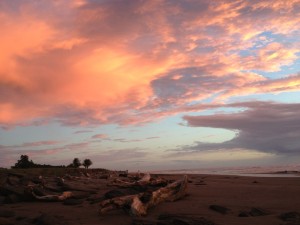Nicaragua is among the poorest countries in the Americas. Its gross domestic product (GDP) in purchasing power parity (PPP) in 2008 was estimated at $17.37 billion USD. Agriculture represents 17% of GDP, the highest percentage in Central America. Remittances account for over 15% of the Nicaraguan GDP. Close to one billion dollars are sent to the country by Nicaraguans living abroad. The economy grew at a rate of about 4% in 2011.
According to the United Nations Development Programme, 48% of the population of Nicaragua live below the poverty line, 79.9% of the population live with less than $2 per day, According to UN figures, 80% of the indigenous people (who make up 5% of the population) live on less than $1 per day.
According to the World Bank, Nicaragua ranked as the 123rd best economy for starting a business. Nicaragua’s economy is “62.7% free” with high levels of fiscal, government, labor, investment, financial, and trade freedom. It ranks as the 61st freest economy, and 14th (of 29) in the Americas.
In March 2007, Poland and Nicaragua signed an agreement to write off 30.6 million dollars which was borrowed by the Nicaraguan government in the 1980s. Inflation reduced from 33,500% in 1988 to 9.45% in 2006, and the foreign debt was cut in half.
Nicaragua is primarily an agricultural country; agriculture constitutes 60% of its total exports which annually yield approximately US $300 million. Nearly two-thirds of the coffee crop comes from the northern part of the central highlands, in the area north and east of the town of Estelí. Soil erosion and pollution from the heavy use of pesticides have become serious concerns in the cotton district. Yields and exports have both been declining since 1985. Today most of Nicaragua’s bananas are grown in the northwestern part of the country near the port of Corinto; sugarcane is also grown in the same district. Cassava, a root crop somewhat similar to the potato, is an important food in tropical regions. Cassava is also the main ingredient in tapioca pudding. Nicaragua’s agricultural sector has benefited because of the country’s strong ties to Venezuela. It is estimated that Venezuela will import approximately $200 million in agricultural goods. In the 1990s, the government initiated efforts to diversify agriculture. Some of the new export-oriented crops were peanuts, sesame, melons, and onions.
Fishing boats on the Caribbean side bring shrimp as well as lobsters into processing plants at Puerto Cabezas, Bluefields, and Laguna de Perlas. A turtle fishery thrived on the Caribbean coast before it collapsed from overexploitation.
Mining is becoming a major industry in Nicaragua, contributing less than 1% of gross domestic product (GDP). Restrictions are being placed on lumbering due to increased environmental concerns about destruction of the rain forests. But lumbering continues despite these obstacles; indeed, a single hardwood tree may be worth thousands of dollars.
During the war between the US-backed Contras and the government of the Sandinistas in the 1980s, much of the country’s infrastructure was damaged or destroyed. Transportation throughout the nation is often inadequate. For example, one cannot travel all the way by highway from Managua to the Caribbean coast. The road ends at the town of Rama. Travelers have to transfer and make the rest of the trip by riverboat down the Río Escondido—a five-hour journey. The Centroamérica power plant on the Tuma River in the Central highlands has been expanded, and other hydroelectric projects have been undertaken to help provide electricity to the nation’s newer industries. Nicaragua has long been considered as a possible site for a new sea-level canal that could supplement the Panama Canal.
Nicaragua’s minimum wage is among the lowest in the Americas and in the world. Remittances are equivalent to roughly 15% of the country’s Gross Domestic Product. Growth in the maquila sector slowed in the first decade of the 21st century with rising competition from Asian markets, particularly China. Land is the traditional basis of wealth in Nicaragua, with great fortunes coming from the export of staples such as coffee, cotton, beef, and sugar. Almost all of the upper class and nearly a quarter of the middle class are substantial landowners.
A 1985 government study classified 69.4 percent of the population as poor on the basis that they were unable to satisfy one or more of their basic needs in housing, sanitary services (water, sewage, and garbage collection), education, and employment. The defining standards for this study were very low; housing was considered substandard if it was constructed of discarded materials with dirt floors or if it was occupied by more than four persons per room.
Rural workers are dependent on agricultural wage labor, especially in coffee and cotton. Only a small fraction hold permanent jobs. Most are migrants who follow crops during the harvest period and find other work during the off-season. The “lower” peasants are typically smallholders without sufficient land to sustain a family; they also join the harvest labor force. The “upper” peasants have sufficient resources to be economically independent. They produce enough surplus, beyond their personal needs, to allow them to participate in the national and world markets.
The urban lower class is characterized by the informal sector of the economy. The informal sector consists of small-scale enterprises that utilize traditional technologies and operate outside the legal regime of labor protections and taxation. Workers in the informal sector are self-employed, unsalaried family workers or employees of small-enterprises, and they are generally poor.
Nicaragua’s informal sector workers include tinsmiths, mattress makers, seamstresses, bakers, shoemakers, and carpenters; people who take in laundry and ironing or prepare food for sale in the streets; and thousands of peddlers, owners of small businesses (often operating out of their own homes), and market stall operators. Some work alone, but others labor in the small talleres (workshops/factories) that are responsible for a large share of the country’s industrial production. Because informal sector earnings are generally very low, few families can subsist on one income. Like most Latin American nations Nicaragua is also characterized by a very small upper-class, roughly 2% of the population, that is very wealthy and wields the political and economic power in the country that is not in the hands of foreign corporations and private industries. These families are oligarchical in nature and have ruled Nicaragua for generations and their wealth is politically and economically horizontally and vertically integrated.
Nicaragua is currently a member of the Bolivarian Alliance for the Americas, which is also known as ALBA. ALBA has proposed creating a new currency, the Sucre, for use among its members. In essence, this means that the Nicaraguan córdoba will be replaced with the Sucre. Other nations that will follow a similar pattern include: Venezuela, Ecuador, Bolivia, Honduras, Cuba, Saint Vincent and the Grenadines, Dominica and Antigua and Barbuda.
Nicaragua is considering construction of a canal linking the Atlantic to the Pacific Ocean, which President Daniel Ortega has said will give Nicaragua its “economic independence.” The project has begun.

